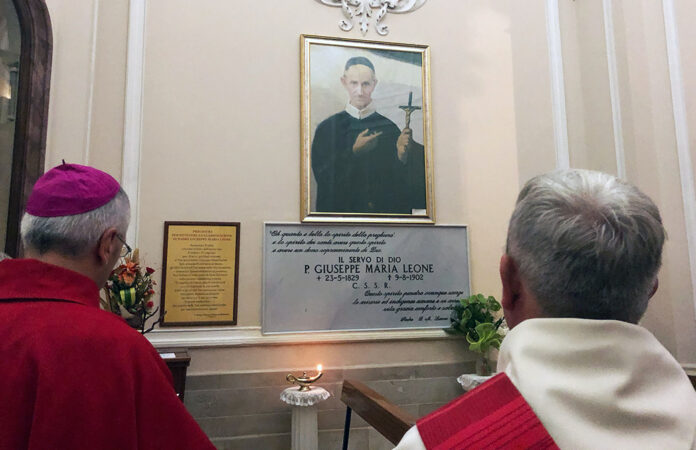
The Servant of God Father Giuseppe Maria Leone, a Redemptorist. An angel of prayer and suffering, a priest dedicated to confession, preaching, spiritual direction, service to the little ones, concrete works, obedience to the Pope, devotion to Mary, and contemplation of Jesus crucified, a giant of the church. He was the soul and inspirer of the initiatives in the Pompeii Valley, not only of a religious nature, but also social, in favor of the poor, the orphans, the children of prisoners, and the marginalized. Initiator of “Christianity in action” in southern Italy in the second half of the 19th century, he followed the words of Saint Alphonsus Mary Liguori. His story of faith, wonders, miracles, and deep spirituality is more relevant than ever and offers insight into the nature of holiness.
TRINITAPOLI – Born on May 23, 1829, in Casaltrinità (today Trinitapoli), Fr. Giuseppe Maria Leone died in Angri (SA), in the community of the Redemptorists, of which he was superior, on August 9, 1902, on Saturday prior to the feast of the ‘Assumption’. The Servant of God had been a fervent herald and defender of the dogma of the Assumption of Mary into Heaven. So much so that he suggested to Bartolo Longo to found an Assumptionist movement. And before he died, the Redemptorists recommended him to defend his cause before Pope Leo XIII (a great friend of the Apulian lawyer, to the point that he appointed him commander). Furthermore, Leo XIII was indebted to Frs. Leone and Longo. From “The Assumption of 1891” (pp. 55-56) by Bartolo Longo we know that on August 15, 1891, the Apulian lawyer of Latiano (BR), while participating in the holy mass, in the Sanctuary of the Virgin of the Rosary in Pompeii, together with Fr. Leone, he was approached by the Jesuit Fr. Cecaro who gave him a letter, signed by the Jesuit Fr. Antonio Domenico D’Aragona, urgently coming from the Pontano College of Naples of the Society of Jesus, in which it was written that the rector of the Institute Fr. Gaetano Mascalchi, a friend of Pope Leo XIII, had been declared “incurable and close to death” by the first doctors of the capital of Campania (Capozzi and De Martino). Bartolo Longo, as soon as he became aware of Fr. Mascalzi’s friendship with Leo XIII, assured Fr. Cecaro of his interest and, with the letter still in hand, informed Fr. Leone. The next day, Father Mascalzi got out of bed, to the great satisfaction of the Pontiff who expressed his gratitude to the founders of the Sanctuary of Pompeii.
When Father Leone ascended to heaven reciting the Gloria Patri, his body was brought to the small church of the community of the Redemptorist Fathers of Angri. Many, out of devotion, touched him with objects or cut off his clothes. An overflowing crowd accompanied the coffin in the final farewell. On a poster from the time, it was written: “The Saint has died. The people of Angri mourn his death.”
Fr. Leone was buried in the Angri cemetery. On October 30, 1920, his mortal remains were transferred to the oratory next to the Basilica of Pagani (SA) in the same tomb where he had laid Saint Alphonsus Maria de Liguori, founder of the Congregation of the Redemptorists and together with those of his confessor Fr. Losito of Canosa di Puglia.
On November 10, 1971, the remains of Father Leone were transferred to the crypt of the Basilica of Pompeii, along with those of Bartolo Longo and his wife, Countess Marianna Farnararo De Fusco Longo, by the will of Monsignor Aurelio Signora, titular archbishop of Nicosia (Cyprus) and Prelate of Pompeii. Finally, he returned to his native Trinitapoli, on December 17, 1983.
GAETANO SAMELE
(www.corriereofanto.it – 09/24/2023)





